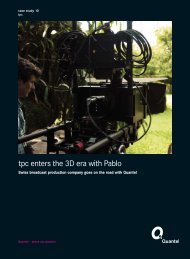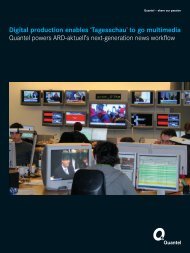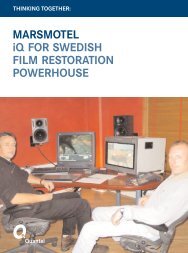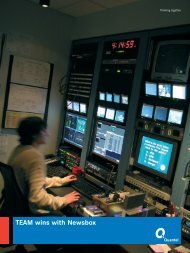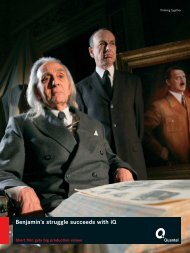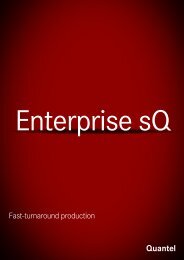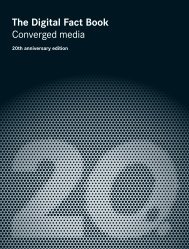Create successful ePaper yourself
Turn your PDF publications into a flip-book with our unique Google optimized e-Paper software.
<strong>Canal</strong>+ goes HD… with <strong>Quantel</strong><br />
Etienne Robial has been the Artistic Director of <strong>Canal</strong>+ since its<br />
beginnings 22 years ago. He is heading up the project to design<br />
the new station branding for one of Europe’s leading pay-TV<br />
broadcasters. Robial’s team is working with the latest <strong>Quantel</strong> gQ<br />
graphic workstations, continuing a tradition that began in 1984<br />
when <strong>Canal</strong>+ revolutionised television graphics using the very first<br />
<strong>Quantel</strong> Paintboxes. Etienne Robial is the inventor of habillage;<br />
literally the ‘dressing up’ of television channels. In this article we<br />
look at how High Definition has become Haute Couture in Paris.<br />
On 4 th November 1984, a revolution occurred in the<br />
French media, with the birth of the country’s first<br />
pay-TV channel. Viewers were greeted with a black<br />
screen (reminiscent of a cinema just before the<br />
feature film is projected), gradually lighting up with a<br />
white diagonal line preparing the way for a rainbowcoloured<br />
ellipse and the letters of CANAL+. The eerie<br />
electro-acoustic music for these opening fireworks,<br />
in sharp contrast to the cutesy jingles and pastel<br />
graphics of the period, set the tone for what was to<br />
become – and remains – arguably the most<br />
sophisticated and provocative channel in Continental<br />
Europe (British viewers got a taste of the <strong>Canal</strong>+<br />
style when one of their star presenters, Antoine de<br />
Caunes, crossed the channel with Eurotrash).<br />
Etienne Robial, designer of the station branding sting<br />
and its avatars, explains his approach: “The <strong>Canal</strong>+<br />
design was intended from the start to give the<br />
channel a unique look and feel. We christened this<br />
signage system habillage.”<br />
To produce this original system, Robial discovered a<br />
machine which he felt could get the job done: the<br />
<strong>Quantel</strong> Paintbox. At the time, there was only one of<br />
these new systems in France, far from Paris in<br />
Angoulême, and the machine was pretty well booked<br />
solid. Robial decided to head for London, the city of<br />
one of his mentors, Martin Lambie-Nairn, founder of<br />
one of the UK’s most prestigious design studios and<br />
famous for his work on the BBC and Channel 4 logos.<br />
For six weeks, he settled in at pioneering facility The<br />
Moving Picture Company (MPC), working day and<br />
night (and mainly at night to obtain lower rates) to<br />
create his logo and hundreds of spin-offs for the<br />
start-up channel.<br />
From the start, <strong>Canal</strong>+ aired about 250 graphic<br />
sequences every day, constantly designing and<br />
adapting its branding and titling to attract viewers.<br />
Paris post facility UMT had just bought a Paintbox as<br />
<strong>Canal</strong>+ was reaching cruising speed. UMT would<br />
shortly thereafter buy France’s first <strong>Quantel</strong> HAL and<br />
Right: Etienne Robial, Artistic<br />
Director, <strong>Canal</strong>+.<br />
Far right: The first <strong>Canal</strong>+ logo,<br />
created on Paintbox.



